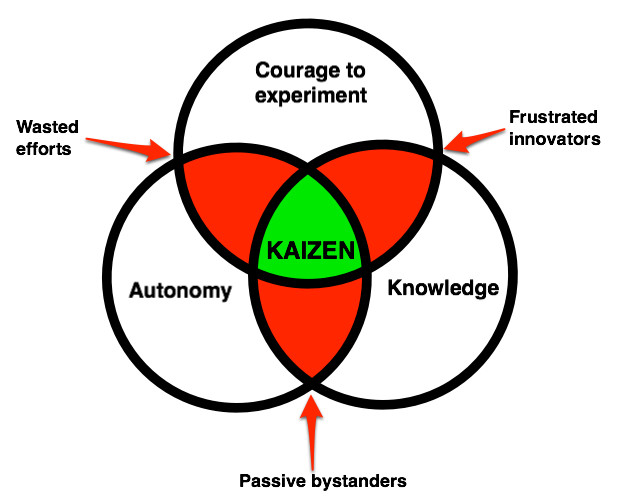Do you start training for a marathon with a 20-mile run? Of course not. Do you go to the gym for the first time and try to bench-press 250 pounds? Not unless you want to get injured.
So why was your first kaizen event a 10-month slog towards some financial improvement goal that didn’t actually change much in your daily work life?
You see this all the time: a company decides to try lean. It hires external consultants, and tackles a sprawling, exceedingly complicated process for their first kaizen effort. After all, that’s how to sell it to the leadership team—by taking on a huge project with significant financial impact. Even assuming the project is successful, by the time it’s complete, the people involved are often burned out, they haven’t really understood and embraced lean, and the 90% of the people in the organization who weren’t involved in the project still have no idea what lean is. The overall problem solving skill of the organization is still pathetically low.
People intuitively understand that the pursuit of athletic fitness is a long process involving the slow but steady buildup of muscular strength, cardiovascular capacity, and flexibility. That’s why marathon training programs last five months. That’s why there are many different weights in the gym. We have to build up to our fitness goal.
Why don’t we treat lean transformations the same way? In my forthcoming book, Building the Fit Organization, I argue that the principles necessary for reaching physical fitness are the same principles needed for organizational “fitness.” One concept common to both is the need to start small, with manageable amounts of work. Consequently, you start training for a marathon with a two-mile run, not a 20-miler. You start a weight training program with light weights, so that you can learn the proper form and not hurt yourself.
But organizations that embark on a lean transformation often do the opposite. Before they’ve built up their problem solving muscles, before they’ve gotten employees to embrace the lean approach, they take on a complex project that requires advanced skills and full support. While that doesn’t doom them to failure, it certainly stacks the deck against them. Needlessly.
At a workshop I recently gave, one attendee said that the first project her group worked on took 15 months to complete. It was only moderately successful -- and more significantly, they haven't done one since. Another attendee said that his group started with small projects lasting a couple of days to a couple of weeks. In the past year and a half, they've done 30 projects, gotten nearly everyone involved, and generated widespread commitment and enthusiasm for lean. To be fair, none of those projects made huge differences in the company's bottom line, but they definitely developed people's problem solving capabilities, and set the stage for more significant improvements in the future.
Whether you're training for a marathon or embarking on an organizational transformation -- which approach do you think will get you to your goal faster?



